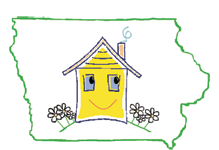What is a healthy home?
According to the National Center for Healthy Housing, a healthy home is a home designed, constructed, maintained, or rehabilitated in a manner that supports the health of residents.
What is the healthy homes initiative?
Iowa's Healthy Homes Initiative is funded by a cooperative agreement with the Centers for Disease Control and Prevention (CDC) through the Healthy People and Healthy Communities through Improved Environmental Health program.
The Healthy Homes Initiative is a collaboration between programs housed at the Iowa Department of Public Health, other public health entities and other organizations. The goal of this initiative is to increase awareness of health and housing issues in Iowa. The initiative supports training on housing issues and provides informational materials to the general public.
Click on the link below to learn about the many hazards that could be lurking inside your own home.
Topics covered are: Lead Poisoning, Asbestos, Secondhand Smoke, Animal Dander, Asthma Triggers, Radon, Bed Bugs, Mold and Mildew, Multiple Chemical Sensitivity, Roach Infestation, Carbon Monoxide, and more.
http://www.healthyhomes360.com/interactive-house
Healthy Homes Project
To help ensure that Monona County housing is safe and healthy, a group of concerned citizens formed a healthy Homes Committee approximately 18 months ago. The purpose of the committee was to develop and promote a practical approach for reducing environmental health hazards in homes while preserving affordable housing. The committee recommended housing ordinances be implemented for the unincorporated county sections. In turn, these model ordinances could be used by incorporated town / cities to determine applicability to their own community. Please view the following documents:
- Letter to the Editor
- Monona County 300 Building Code
- Monona County 310 Rental Housing
- Monona County 320 Dangerous Building
- Monona County 330 Property Maintenance
- Public Meeting Notice
Food Safety at Home
While the food supply in the United States is one of the safest in the world, CDC estimates that each year 76 million cases of foodborne illness occur.
CLEAN hands and surfaces often. Bacteria can spread throughout the kitchen and get on hands, cutting boards, knives, and countertops.
SEPARATE: Don't cross-contaminate one food with another. Cross-contamination occurs when bacteria is spread from a food to a surface or from a surface to another food.
COOK foods to proper temperatures. Use a food thermometer - you can't tell food is cooked safely by how it looks.
|
Safe Cooking Temperatures as measured with a food thermometer |
Internal Temperature |
| Ground Beef | 160°F |
| Fresh Beef, Veal, Lamb | 145°F |
| Poultry | 165°F |
| Fresh Pork | 160°F |
| Eggs & Egg Dishes | |
| Eggs | Cook until yolk & white are firm |
| Egg dishes | 160°F |
| Seafood | 145°F |
| Leftovers & Casseroles | 165°F |
CHILL: Refrigerate foods promptly. Cold temperatures slow the growth of harmful bacteria. Chilling food properly is one of the most effective ways to reduce the risk of foodborne illness.
- Cool the fridge to 40 °F or below, and use an appliance thermometer to check the temperature.
- Chill leftovers and takeout foods within 2 hours, and divide food into shallow containers for rapid cooling.
- Thaw meat, poultry, and seafood in the fridge, not on the counter, and don't overstuff the fridge.
Download the USDA Food Safety Fact Sheets. The Food Safety and Inspection Service page for consumers about the importance of safe food handling and how to reduce the risks associated with food borne illness.
Topics
- Asbestos
-
Bed Bugs
- IDPH Bed Bugs Fact Sheet
- Guidance on Bedbug Management
- Current Practices in Bed Bug Identification, Remediation, and Follow-up Webinar
- Linn County Public Health bed bug website
- Bed bug biology, treatment information, and pesticides from the EPA
- Carbon Monoxide
- Cockroach Fact Sheet
- Fire Safety
- Lead
- Mold
- Pest Control
- Radon
2014 NATIONAL RADON MONTH PRESS RELEASE
Does Your Home Have High Radon Levels?
PROTECT YOURSELF FROM RADON GAS
Radon is a radioactive gas that is colorless and odorless. It originates in the soil from the natural decay of uranium and radium that was ground-up and left behind by glaciers. Radon gas may enter your home in the following ways:
- Exposed soild or rock crawlspaces
- Floor wall joints
- Floor drains
- Cracks or flaws in floor slab
- Hollow objects - support posts
- Around utility posts
- Cracks or flaws in foundation walls
The only way to know for sure if you have a radon problem is to have your home tested.
For more information on Radon see the following links:
Radon & You: What you need to know to protect you
and your family
Iowa Radon Home - Buyers and Sellers Fact Sheet

Download a copy of “Healthy Homes, Healthy People”
http://www.idph.state.ia.us/eh/common/pdf/healthy_homes/healthy_homes_brochure.pdf
Download a copy of the “Home Maintenance Checklist”
http://www.healthyhomestraining.org/Documents/Maintain_the_House/HH_Maintenance_Checklist.pdf